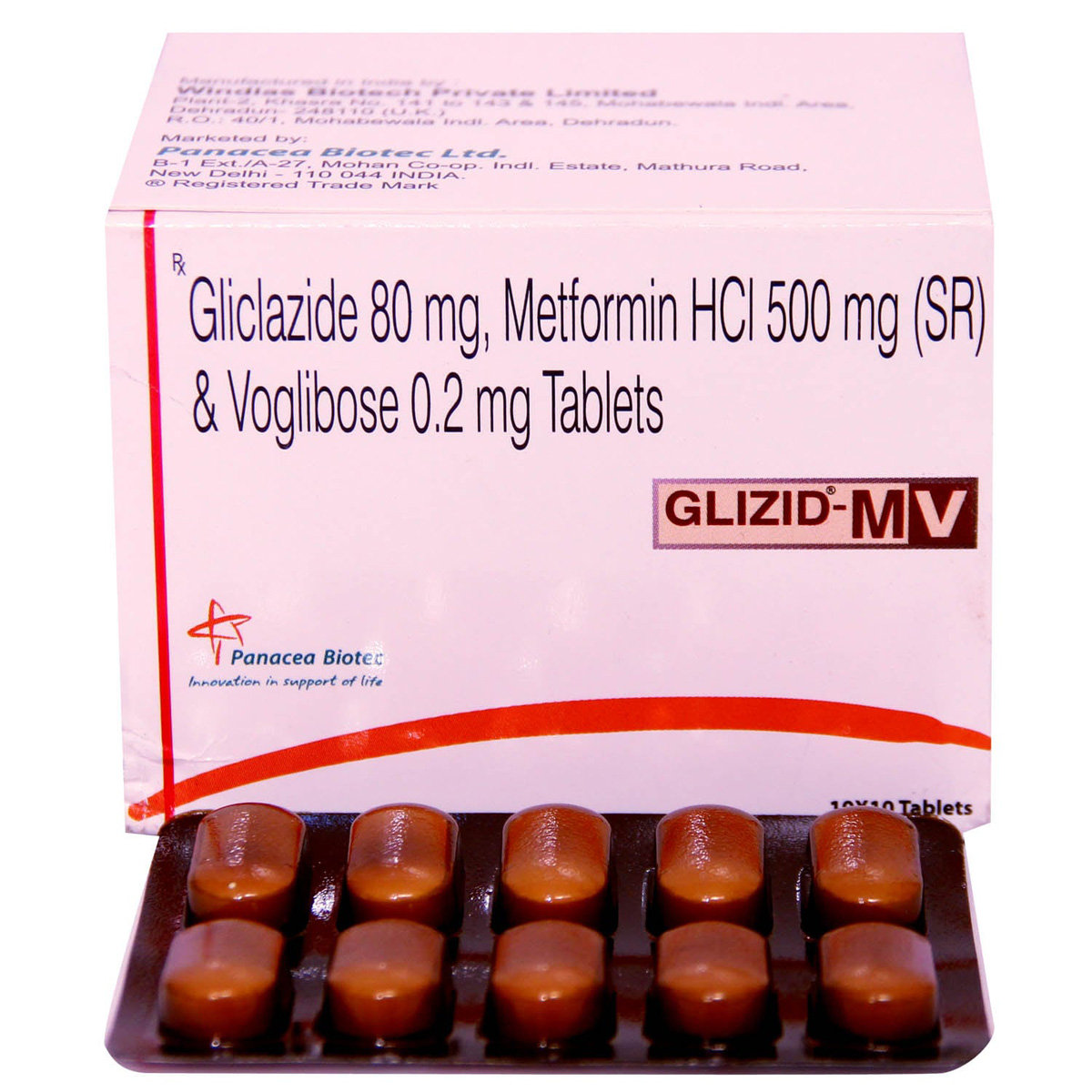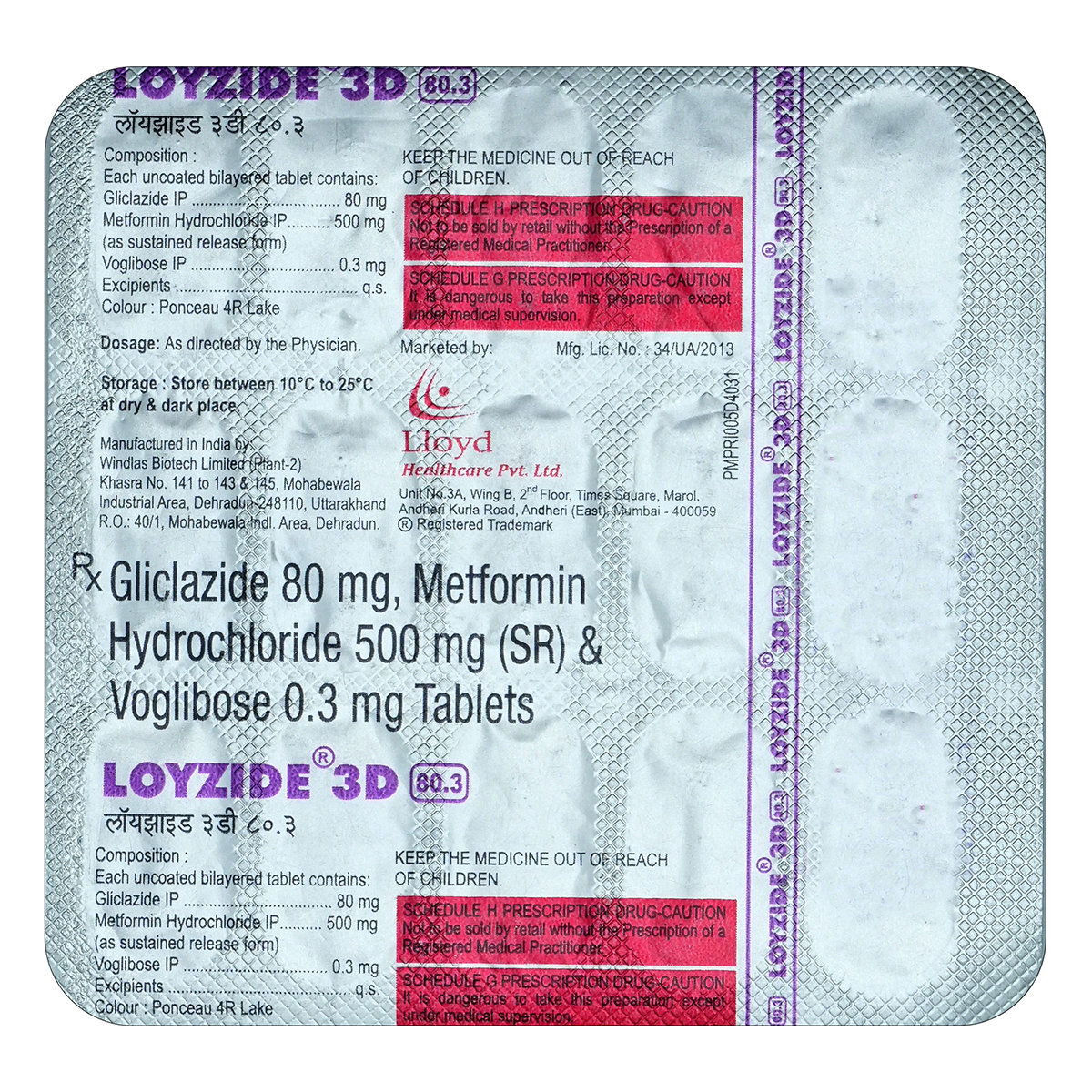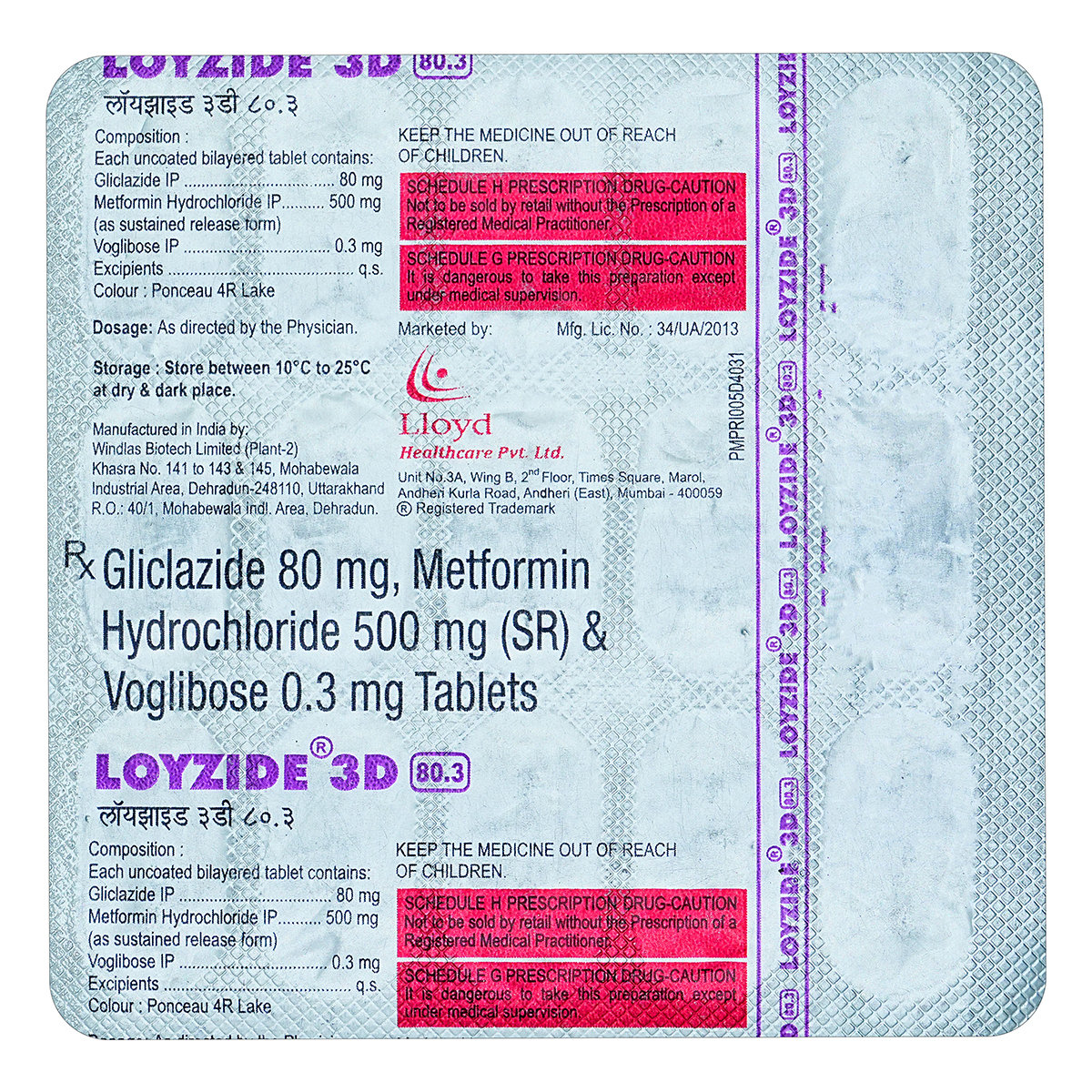Gliclazide+metformin+voglibose
About Gliclazide+metformin+voglibose
Gliclazide+metformin+voglibose belongs to a class of medicine known as an antidiabetic primarily indicated in treating type 2 diabetes mellitus. Type 2 diabetes is a chronic or lifelong condition affecting how your body processes glucose. People with type 2 diabetes either do not produce enough insulin, or if at all the insulin is produced, it is unable to perform its function in the body (insulin resistance). Due to this, the blood glucose level increases, and symptoms such as frequent urination, increased thirst, and increased hunger start. It can lead to serious complications like skin infection, eye problems (retinopathy), nerve damage (neuropathy), diabetic foot (foot ulcer), kidney disease (nephropathy), high blood pressure and even stroke.
Gliclazide+metformin+voglibose combines three antidiabetic drugs: Voglibose, Metformin, and Gliclazide. Voglibose is an alpha-glucosidase inhibitor that prevents the breakdown of complex sugars into simple sugars such as glucose. In this way, it prevents the sudden rise in sugar levels after every meal. Gliclazide is a 'sulfonylurea' that acts by increasing the insulin released by the pancreas. On the other hand, Metformin, which is a 'biguanide', acts by lowering the glucose production in the liver, delaying glucose absorption from the intestines, and increasing the body's response to insulin. In a nutshell, the three medicines together prevent blood glucose levels from rising to very high levels, thus keeping your Diabetes under control. Gliclazide+metformin+voglibose act together to keep your blood sugar levels under check. The strict control of blood sugars is especially important to mention the many disabling side effects of Diabetes. Gliclazide+metformin+voglibose shows optimum effects when taken along with healthy lifestyle changes like weight loss, regular exercise, healthy diet, etc.
Gliclazide+metformin+voglibose should be taken with food to avoid an upset stomach. Gliclazide+metformin+voglibose should be taken at the same time of the day each time for the best results. For better advice, your doctor will decide what dose should be taken, which can change quickly depending on your condition. A common side effect of Gliclazide+metformin+voglibose is hypoglycemia (low blood glucose levels), characterized by dizziness, sweating, palpitations, hunger pangs, dry mouth, skin, etc. So, to avoid hypoglycemia, you should not miss meals and also should carry some form of sugar along with you. Other side effects include taste change, nausea, diarrhoea, stomach pain, headache, and upper respiratory symptoms.
You should not take Gliclazide+metformin+voglibose if you have diabetic ketoacidosis (excess acids in your blood). Gliclazide+metformin+voglibose should not be stopped even if you feel better, without consulting your doctor as your sugar level keeps changing. If you stop taking Gliclazide+metformin+voglibose abruptly, it may increase your sugar levels which could further increase the risk of eyesight loss (retinopathy), kidney (nephropathy), and nerve damage (neuropathy). Gliclazide+metformin+voglibose should not be taken if you have type 1 diabetes mellitus or severe kidney or liver disease. Please inform your doctor if you have any heart disease, are or are planning to get pregnant, or are breastfeeding.
Uses of Gliclazide+metformin+voglibose
Medicinal Benefits
Gliclazide+metformin+voglibose is a combination of three anti-diabetic drugs: Voglibose, Metformin, and Gliclazide. Voglibose is an alpha-glucosidase inhibitor that prevents the breakdown of complex sugars into simple sugars such as glucose. In this way, it prevents the sudden rise in sugar levels after every meal. Gliclazide is a 'sulfonylurea' that acts by increasing the insulin released by the pancreas. On the other hand, Metformin, which is a 'biguanide', works by lowering the glucose production in the liver, delaying glucose absorption from the intestines, and increasing the body's response to insulin. In a nutshell, the three medicines prevent blood glucose levels from rising to very high levels, thus keeping your Diabetes under control. Gliclazide+metformin+voglibose act together to keep your blood sugar levels under check. The strict control of blood sugars is especially important to mention the many disabling side effects of Diabetes. Gliclazide+metformin+voglibose shows optimum effects when taken along with healthy lifestyle changes like weight loss, regular exercise, healthy diet, etc.
Directions for Use
Storage
Side Effects of Gliclazide+metformin+voglibose
- Hypoglycemia (low blood glucose level)
- Dizziness
- Sweating
- Palpitations
- Hunger pangs
- Dry mouth and skin
Drug Warnings
Some diabetic patients taking Gliclazide+metformin+voglibose may develop a rare but serious condition called lactic acidosis. In this condition, too much lactic acid is accumulated in the blood. So, your liver and kidney's proper functioning is required to eliminate excess lactic acid from the blood. You should not take Gliclazide+metformin+voglibose if you have kidney disease, as measured by a blood test. Gliclazide+metformin+voglibose may lower vitamin B12 levels, so try to have blood tests for annual blood and vitamin. Gliclazide+metformin+voglibose, when used with or without insulin, tends to lower the blood sugar level extremely. So, the doctor may reduce the dose of insulin. Gliclazide+metformin+voglibose may lower your thyroid-stimulating hormone (TSH), so an annual check-up of TSH is suggested.
Drug Interactions
Drug-Drug Interactions: Gliclazide+metformin+voglibose may interact with insulin, high blood pressure-lowering pills (hydrochlorothiazide, amlodipine), water pills/diuretics (furosemide), heart failure-related medicines (digoxin), anti-hypertensive (metoprolol), steroids (prednisolone), thyroid hormones, etc. So, tell your doctor if you are using these drugs before taking Gliclazide+metformin+voglibose.
Drug-Food Interactions: Taking Gliclazide+metformin+voglibose with alcoholic beverages may increase the risk of a rare but serious and potentially life-threatening condition known as lactic acidosis (build-up of lactic acid in the blood) and hypoglycemia.
Drug-Disease Interactions: Gliclazide+metformin+voglibose should be avoided in patients with vitamin B12 deficiency, kidney problems, liver problems, cardiovascular disease (heart-related issues), and low blood sugar level (hypoglycemia) as it may worsen the condition.
Drug-Drug Interactions Checker List:
Safety Advice

Alcohol
unsafeYou are recommended not to consume alcohol along with Gliclazide+metformin+voglibose to avoid unpleasant side-effects.

Pregnancy
unsafeAs the data around the use of Gliclazide+metformin+voglibose in pregnant women is limited, the use of Gliclazide+metformin+voglibose in pregnancy is restricted. It is highly recommended to consult your doctor before taking this drug in case you are pregnant.

Breast Feeding
cautionGliclazide+metformin+voglibose should not be used in nursing mothers unless clearly necessary. So, inform your doctor if you are a nursing mother. Your doctor will weigh the benefits and potential risks before prescribing Gliclazide+metformin+voglibose.

Driving
cautionGliclazide+metformin+voglibose may cause hypoglycemia (low blood sugar levels) whose symptoms include unusual sleepiness, shivering, palpitations, sweating, etc. This may affect your ability to drive. Use caution while driving or doing anything that requires concentration.

Liver
cautionGliclazide+metformin+voglibose to be taken with caution, especially if you have a history of liver diseases/conditions. The dose may have to be adjusted by your doctor.

Kidney
cautionGliclazide+metformin+voglibose to be taken with caution, especially if you have a history of Kidney diseases/conditions. The dose may have to be adjusted by your doctor.

Children
unsafeThe safety and efficacy of Gliclazide+metformin+voglibose in children have not been established. Gliclazide+metformin+voglibose is not recommended in children.
Habit Forming
Diet & Lifestyle Advise
- Fill your half plate with starchy veggies, a quarter with proteins, and a quarter with whole grains.
- Eat at regular intervals. Do not take the long gap between a meal or snack.
- Monitor your blood sugar level regularly, especially when there are a lot of fluctuations.
- Invest in at least 150 minutes of moderate-intensity physical activity and 15 minutes of high-intensity exercise weekly.
- Lose weight gradually to achieve a healthy body mass index (18.5 to 24.9).
- Replace refined carbohydrate-containing foods with whole grain foods and increase intake of fruits, veggies, and other fibre-enriched foods.
- Reduce saturated fat (or hidden fats) intake in food like chips, crisps, pastries, biscuits, and samosas. Choose omega-3 fatty acid-containing oils for daily cooking. For frying, you may use palm oil, mustard oil, groundnut oil, rice bran oil, and safflower oil.
- Do not take stress as it may elevate your blood sugar level. You may adopt stress management techniques like mindfulness, yoga or meditation to control stress related to blood sugar changes.
- Opt for low-fat dairy products (low-fat yoghurt, fat-free milk, cheese, etc.).
- Keep your blood pressure as normal (120/80) as possible, as it reduces the risk of cardiovascular diseases in diabetes patients.
Special Advise
- Keep taking the drug even if you think your blood sugar levels are under control. If you miss a dose, do not take a larger dose. Consult your treating physician for advice.
- Take short, frequent meals, and avoid prolonged fasting when taking this drug. Beware of hypoglycemia symptoms, including sweating, dizziness, palpitations, shivering, intense thirst, dry mouth, dry skin, frequent urination etc. Whenever you experience the symptoms mentioned above, immediately consume 5-6 candies, three glucose biscuits, or three teaspoons of honey/sugar and get in touch with your physician. Make sure to carry these with you at all times, especially for long travels.
- Before the doctor prescribes this medicine, it is always better that your physician knows about any underlying conditions like kidney or liver disease, prior heart attack, alcohol intake, etc.
- Avoid drinking alcohol while on this drug as it increases the risk of hypoglycemia (a decrease in blood sugar which might be fatal in some cases) and lactic acidosis (when the lactic acid increases in the body, which impacts the functioning of various organs in the body).
- Try to quit smoking and reduce your intake of carbohydrate-rich food like potatoes, rice, mangoes, bread, sugar etc.
- Remember, lifestyle modifications are the most important step in controlling blood sugar levels.
Patients Concern
Disease/Condition Glossary
Diabetes Mellitus type 2 is a condition in which either the body stops producing enough insulin (the hormone which helps to decrease sugar levels in the blood) or there is resistance to the action of insulin. As a result, excessive insulin is produced, but it fails to act on the body's organs. Symptoms of type 2 diabetes include feeling exhausted all time, feeling thirsty, having blurry vision, and having the urge to urinate (pee) more often. Complications of type 2 diabetes include skin infection, eye problems (retinopathy), nerve damage (neuropathy), delayed wound healing, diabetic foot (foot ulcer), kidney disease (nephropathy), high blood pressure, and even stroke. Both low and high blood sugar levels can be dangerous and should be treated as soon as possible. Your H1bA1C below 5.7% is normal, 5.7-6.4% confirms the prediabetes stage, and 6.5% or greater states a diabetes condition.
FAQs
Eating nutritious food with a good workout regimen with Gliclazide+metformin+voglibose can make a lot of difference in managing type 2 diabetes. Exercising causes the heartbeat to a little fast and breathing hard, making muscles use more glucose and lower sugar levels. It also helps in making insulin the body to work better.
Type-2 diabetes generally does not affect healthy children and teens, but it may affect children who are obese, which is also known as Childhood Obesity.
Hypoglycemia refers to low blood sugar levels, and it is one of the side effects of Gliclazide+metformin+voglibose. Gliclazide+metformin+voglibose helps to lower blood glucose levels and to make them as normal as possible. Still, sometimes it may also cause Hypoglycemia, which may also occur if you miss or delay your food, drink alcohol, over-exercise, or take other antidiabetic medicine along with this medicine. It is important to monitor blood sugar levels regularly.
It is suggested to take other medicines only after consulting with a doctor to avoid unpleasant side effects. Tell your doctor if you have taken other medicines or herbal supplements while taking Gliclazide+metformin+voglibose.
If you feel thirsty after taking Gliclazide+metformin+voglibose, it may be because of dehydration or loss of fluids. Increase intake of fluids, if even then you feel thirsty please consult your doctor.
It has been reported that long-term usage of Gliclazide+metformin+voglibose can cause vitamin B12 deficiency as it interferes with the absorption of vitamin B12 in the stomach. The symptoms of a vitamin B12 lack include fatigue, nerve problems, tingling sensation and numbness in hands and feet, weakness, urinary problems, affected mental status, and difficulty maintaining balance. These symptoms can be managed by taking Vitamin B12 supplements as advised by your doctor.
If you have symptoms like increased hunger, increased thirst, frequent urination (usually at night), unexplained weight loss, fatigue, blurred vision, slow wound/sores healing, and frequent infections, contact the doctor, as it can be a condition of type 2 diabetes.
If you feel that your blood sugar level is decreasing and you are feeling weak, immediately eat sugar candies or drink sugary beverages. It will help to balance the blood sugar level in your body. So, it is advisable to keep sugar candies with you.
In some researches, it has been seen that regular exercise can significantly reduce the chances of developing type 2 diabetes. Even walking for an hour or involved in any type of workout can help in losing weight and reduces the chances of occurrence of diabetes.





